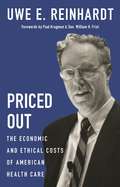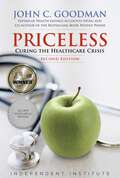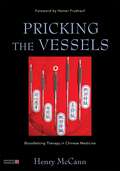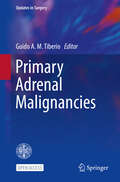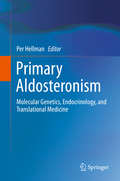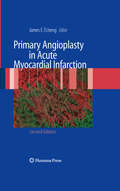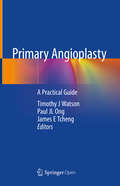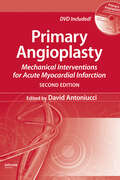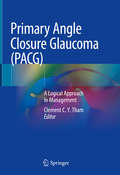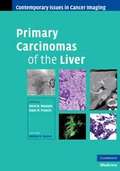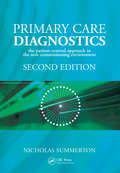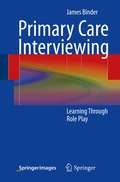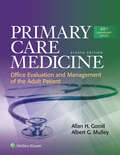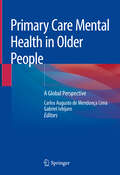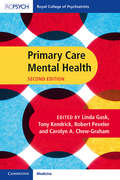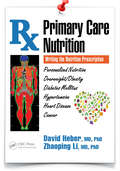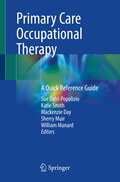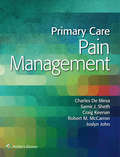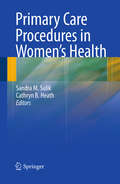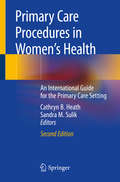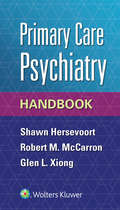- Table View
- List View
Priced Out: The Economic and Ethical Costs of American Health Care
by Uwe E. ReinhardtFrom a giant of health care policy, an engaging and enlightening account of why American health care is so expensive—and why it doesn't have to beUwe Reinhardt was a towering figure and moral conscience of health care policy in the United States and beyond. Famously bipartisan, he advised presidents and Congress on health reform and originated central features of the Affordable Care Act. In Priced Out, Reinhardt offers an engaging and enlightening account of today's U.S. health care system, explaining why it costs so much more and delivers so much less than the systems of every other advanced country, why this situation is morally indefensible, and how we might improve it.The problem, Reinhardt says, is not one of economics but of social ethics. There is no American political consensus on a fundamental question other countries settled long ago: to what extent should we be our brothers' and sisters' keepers when it comes to health care? Drawing on the best evidence, he guides readers through the chaotic, secretive, and inefficient way America finances health care, and he offers a penetrating ethical analysis of recent reform proposals. At this point, he argues, the United States appears to have three stark choices: the government can make the rich help pay for the health care of the poor, ration care by income, or control costs. Reinhardt proposes an alternative path: that by age 26 all Americans must choose either to join an insurance arrangement with community-rated premiums, or take a chance on being uninsured or relying on a health insurance market that charges premiums based on health status.An incisive look at the American health care system, Priced Out dispels the confusion, ignorance, myths, and misinformation that hinder effective reform.
Priceless: Curing the Healthcare Crisis
by John C. GoodmanIn this long-awaited updated edition of his groundbreaking work Priceless: Curing the Healthcare Crisis, renowned healthcare economist John Goodman ("father" of Health Savings Accounts) analyzes America&’s ongoing healthcare fiasco—including, for this edition, the failed promises of Obamacare.Goodman then provides what many critics of our healthcare system neglect: solutions. And not a moment too soon. Americans are entangled in a system with perverse incentives that raise costs, reduce quality, and make care less accessible. It&’s not just patients that need liberation from this labyrinth of confusion—it&’s doctors, businessmen, and institutions as well. Read this new work and discover: why no one sees a real price for anything: no patient, no doctor, no employer, no employee; how Obamacare&’s perverse incentives cause insurance companies to seek to attract the healthy and avoid the sick; why having a preexisting condition is actually WORSE under Obamacare than it was before—despite rosy political promises to the contrary; why emergency-room traffic and long waits for care have actually increased under Obamacare; how Medicaid expansion spends new money insuring healthy, single adults, while doing nothing for the developmentally disabled who languish on waiting lists and children who aren&’t getting the pediatric care they need; how the market for medical care COULD be as efficient and consumer-friendly as the market for cell phone repair... and what it would take to make that happen; how to create centers of medical excellence, which compete to meet the needs of the chronically ill; and much, much more... Thoroughly researched, clearly written, and decidedly humane in its concern for the health of all Americans, John Goodman has written the healthcare book to read to understand today&’s healthcare crisis. His proposed solutions are bold, crucial, and most importantly, caring. Healthcare is complex. But this book isn&’t. It&’s clear, it&’s satisfying, and it&’s refreshingly human. If you read even one book about healthcare policy in America, this is the one to read.
Pricking the Vessels: Bloodletting Therapy in Chinese Medicine
by Heiner Fruehauf Henry MccannThe first text on bloodletting therapy for Western practitioners of Chinese medicine, this authoritative text explores the theory and function of bloodletting, and provides detailed instruction on its clinical use. Bloodletting therapy, which works to remove internal and external disruptions to the system through the withdrawal of small quantities of blood, has numerous benefits, especially concerning the treatment of complex or chronic disease. Yet the technique is often met with alarm in the West and side-lined in favour of less controversial treatments such as fine-needle acupuncture, and moxibustion. This book provides a concise overview of its theory, historical and contemporary relevance, and clinical guidance. With detailed reference to the classic texts, the author clarifies the fundamental Chinese medical theory related to blood and the network vessels, and provides an in-depth discussion of the benefits of and practice guidelines for bloodletting. The book includes a chapter on the classical acupuncture techniques of Tung Ching Chang whose work is attracting increasing attention in the West. Through the exploration of classic texts and contemporary standards, the book provides everything needed to gain a comprehensive understanding of the technique and to encourage its use as a viable treatment option in the West. It will be an invaluable addition to the resources available for acupuncturists, as well as students and practitioners of Chinese medicine more generally, including those interested in all Chinese approaches to health.
Primary Adrenal Malignancies (Updates in Surgery)
by Guido A. M. TiberioDissemination of knowledge is the best and only strategy capable of improving clinical management in rare and ultra-rare malignancies, including primary adrenal malignancies. It is preliminary to any further healthcare policy such as, for example, the centralization of cases in referral institutions. Adrenal primary malignancies are probably the rarest among rare pathologies. This epidemiological consideration is at the origin of a vicious circle: the lack of preoperative diagnosis leads to inappropriate surgical procedures and to inadequate follow-up and systemic therapy strategies. Furthermore, when malignancy is recognized, the relative role of systemic, surgical, or other local ablative techniques is often misinterpreted. All this produces a negative impact on survival, also in patients who could have been cured with a correct therapeutic strategy. This open access book provides a user-friendly exploration of these rare conditions, using a transversal approach common in modern precision medicine. The text covers various clinical aspects, including epidemiology, genetics, molecular medicine, imaging, and surgery. Guidelines for managing syndromic situations are provided. The book thoroughly addresses all the different surgical issues and emphasizes the importance of pathology in assessing prognosis. The pivotal role of medical oncologists in managing these patients is explored, along with alternative treatments such as nuclear medicine and radiotherapy. Finally, the book highlights the latest preclinical research and its implications for translational medicine.
Primary Aldosteronism
by Per HellmanPrimary Aldosteronism (PA) is a disease caused by the overproduction of aldosterone hormone from the adrenal glands. PA causes hypertension and the majority with this disease are undiagnosed for PA. There are new insights into this matter by using biochemistry as well as advanced radiology. In 2011, a breakthrough in the genetic derangements came, identifying a mutated potassium channel gene - KCNJ5 - in about 40% of PA with adenoma. Chapters in this book include a history of the disorder, epidemiology, genetics derangements, the KCNJ5 mutations and phenotype and more.
Primary Angioplasty in Acute Myocardial Infarction
by James E. TchengThe emergency treatment of acute myocardial infarction (AMI)-one of the leading causes of death throughout the world-with immediate cardiac cathterization and percutaneous coronary intervention, or primary angioplasty, is now considered the optimal approach to this deadly disorder. In Primary Angioplasty in Acute Myocardial Infarction, Second Edition, leading investigators and experienced clinicians collect and summarize the world's literature and augment this with practical wisdom concerning this critically important form of care. Technical, professional, and administrative aspects are reviewed in clear detail. Among the topics covered are the technique and technology of direct angioplasty, patient selection, regulatory issues, performance metrics, clinical trials and outcomes, adjunctive pharmacology, economics, and implications for the health care system. The practicing cardiologist will appreciate the many useful how-to tips and pointers; the cardiology fellow will value the a-to-z approach that addresses all critical issues; and the administrator will learn the details of creating, maintaining, evaluating, and justifying a successful program. Comprehensive and highly practical Primary Angioplasty in Acute Myocardial Infarction, Second Edition summarizes for today's cardiologists, internists, family practitioners, and emergency room physicians all the accumulated knowledge and experience needed to ensure that primary angioplasty becomes the standard of care for acute myocardial infarctions.
Primary Angioplasty: A Practical Guide (Contemporary Cardiology)
by Timothy J Watson Paul Jl Ong James E TchengThis book is open access under a CC BY 4.0 license.This quick-reference handbook offers a concise and practical review of key aspects of the treatment of ST-segment elevation myocardial infarction (STEMI) in the era of primary percutaneous coronary intervention (PPCI). In the context of STEMI, PPCI is the preferred mode of emergency revascularization. Access to PPCI is rapidly increasing and is now routinely practiced in both general and specialist hospitals and there has been a recent emphasis on developing STEMI networks to enhance and expedite the referral pathway. This coupled with concurrent developments to enhance the safety and efficacy of the PPCI procedure has heralded an era where STEMI interventions are increasingly considered an important subspecialty within interventional cardiology. Written by leading cardiologists who have been instrumental in the adoption of PPCI in their respective institutions, the book provides junior and senior cardiologists alike with insightful and thought-provoking tips and tricks to enhance the success of PPCI procedures, which may in turn translate into direct improvements in outcomes. The book is also relevant for healthcare providers and emergency department physicians.
Primary Angioplasty: Mechanical Interventions for Acute Myocardial Infarction, Second Edition
by David AntoniucciThe Second Edition of Primary Angioplasty provides an update on the rationale, techniques, and effectiveness of direct percutaneous mechanical revascularization for acute myocardial infarction. Through the use of "real world" methods, clinical perspectives, and mechanical support, this comprehensive resource guides interventional cardiologists and
Primary Angle Closure Glaucoma (PACG): A Logical Approach in Management
by Clement C. Y. ThamThis book aims to provide the readers with an up-to-date and evidence-based management approach for primary angle closure glaucoma (PACG), which makes effective and safe use of all the interventions currently available. The book presents to the glaucoma subspecialists and the general ophthalmologists a clear and concise introduction to the latest advances in the management of primary angle closure glaucoma (PACG), from the latest imaging technologies to objectively quantify the drainage angle closure and structural glaucomatous progression, to an up-to-date review of the laser and surgical options for treating PACG. The laser and surgical interventions include laser peripheral iridotomy, laser peripheral iridoplasty, lens extraction alone or in combination with other glaucoma surgery, filtration surgery (including minimally-invasive and non-penetrating variants), goniosynechialysis (GSL), glaucoma drainage device implantation, and cyclodestructive procedures. This informative book, written based on the authors’ vast clinical, teaching, and research experience in this field, will offer the readers in-depth and useful resources on PACG.
Primary Carcinomas of the Liver
by Hero K. Hussain Isaac R. FrancisPrimary carcinomas of the liver are increasing in incidence in the developed world, probably due to dietary and environmental factors as well as the known role of infective agents such as Hepatitis C. They are usually diagnosed in the advanced stages and carry high morbidity and mortality. This volume summarises the latest developments in imaging of primary hepatic carcinomas, emphasising the multidisciplinary approach to the care of patients. In addition to extensive chapters on the radiological issues surrounding diagnosis and staging of the malignancies, individual chapters on epidemiology, pathology, and surgical and non-surgical treatment options are included. All treatment options are considered for both HCC and cholangiocarcinoma, including newer techniques such as TACE. Only by a well orchestrated multidisciplinary team approach including epidemiologists, diagnostic radiologists, hepatologists, oncologic surgeons, radiation oncologists, and pathologists can these complex malignancies be managed successfully.
Primary Care Diagnostics: The Patient-Centred Approach in the New Commissioning Environment (Radcliffe Ser.)
by Nicholas SummertonPrimary care diagnostics involves interpreting and applying information obtained directly from the patient. It re-emphasises the importance of the patient's input into the diagnostic process and of using investigations only after careful consideration has been given to the costs and benefits from both the patient's and the health service's perspectives. The first edition of this book, Patient-Centred Diagnosis, was acclaimed for returning the patient to the centre of diagnostic input and focusing on the interaction between doctor and patient. This revised and augmented new edition, Primary Care Diagnostics, expands on that success; it reflects the broader and equally important issues considered by clinicians or commissioners focusing on the diagnostic approach within primary care, and includes entirely new chapters on cancer and commissioning. Family doctors and other healthcare professionals in the primary care team will find this an enlightening guide. Private and commercial providers of primary care clinical assessment and diagnostic services will also find it of great interest, as will healthcare managers, as well as policy makers and shapers. From reviews of the First Edition: 'Even the more technical sections are expressed in a straightforward language. The style is clear, flowing and engaging. Useful.' THE BRITISH JOURNAL OF GENERAL PRACTICE 'Thought provoking. Clear, understandable and uses real examples from general practice. This is a book for GPs who wish to take a step back from daily practice and think about the reasons behind their actions.' PULSE
Primary Care Ethics
by Deborah BowmanRelevant for the entire primary care team, this book provides a diverse range of perspectives on current topical issues. Healthcare ethics is a subject of increasing interest, especially when it related to some of the challenging themes regularly discussed in the media. Until now there has been little useful literature for those in primary care, where ethical problems are often experienced with a unique set of issues. Primary Care Ethics is rigorous and academic, while remaining highly accessible for the full range of practitioners. Moral and legal aspects are clearly distinguished throughout, and the theme-based approach is stimulating and original. In providing greater depth and breadth in this subject than has been available previously, the book is both practical and thought-provoking, and essential reading for everyone, whether in academic, training or practice-based primary care.
Primary Care Interviewing
by James BinderPrimary care is complex, unpredictable, and requires a biopsychosocial orientation. An indispensable teaching resource, Primary Care Interviewing: Learning Through Role Play thoroughly details how to use role play to teach the basics and more complex aspects of medical interviewing skills to trainee clinicians. Role playing is ideally suited to teach clinicians how to interview and relate to patients, and this unique and concise title includes not only sample role plays and dialog but also a wealth of accompanying online video role plays to enhance the learning process. Part one presents how to teach basic interviewing skills needed for effective communication, such as joining, promoting self- awareness, open-ended communication, dealing with emotions, structuring skills, and asking questions to uncover concerns and related beliefs, or theories of illness. Part two addresses the teaching of specific, more complex interviewing skills, such as addressing a patient's mental health issues, sexual health, somatic conditions, and giving bad news.
Primary Care Medicine
by Allan GorollLong regarded as “the book” in the field for in-depth learning as well as decision support at the point of care, Primary Care Medicine, 8th Edition, continues its tradition as a comprehensive, evidence-based, action-oriented information resource. Presented in companion electronic format updated quarterly, its problem-based orientation spans the full spectrum of problems encountered in adult primary care practice. Chapters address screening, diagnosis, prevention and management, including indications for referral and approaches to patient education and shared decision making. Clear, practical, bulleted recommendations and an extensive annotated bibliography of best references follow detailed discussions of pathophysiology, clinical presentation, differential diagnosis, and strategies for workup and treatment. Now with its 40th-anniversary edition, this exceptional text is a must-have resource for physicians, nurse practitioners, physician assistants, students, and residents- offering the most complete and up-to-date resource available for primary care education and practice.
Primary Care Medicine: Office Evaluation And Management Of The Adult Patient
by Allan GorollLong regarded as “the book” in the field for in-depth learning as well as decision support at the point of care, Primary Care Medicine, 8th Edition, continues its tradition as a comprehensive, evidence-based, action-oriented information resource. Presented in companion electronic format updated quarterly, its problem-based orientation spans the full spectrum of problems encountered in adult primary care practice. Chapters address screening, diagnosis, prevention and management, including indications for referral and approaches to patient education and shared decision making. Clear, practical, bulleted recommendations and an extensive annotated bibliography of best references follow detailed discussions of pathophysiology, clinical presentation, differential diagnosis, and strategies for workup and treatment. Now with its 40th-anniversary edition, this exceptional text is a must-have resource for physicians, nurse practitioners, physician assistants, students, and residents- offering the most complete and up-to-date resource available for primary care education and practice.
Primary Care Mental Health in Older People: A Global Perspective
by Carlos Augusto de Mendonça Lima Gabriel IvbijaroThis book is a practical resource that will support the delivery of holistic mental health interventions in the primary and community care setting for older people. Primary care delivery is discussed in relation to both functional mental health problems, such as anxiety, depression, and psychotic and personality disorders, and acquired organic mental disorders of old age, such as dementia, cognitive impairments, and delirium. Careful consideration is paid to the complex relationship between mental and somatic health problems, as well as the impacts of multimorbidity and polypharmacy. Further topics include, for example, epidemiology, wider determinants of health, different care models, history taking, neurocognitive and capacity assessment, and pharmacological, psychological, and physical interventions.The wider goals of the book are to support the development of community resilience and self-care in older people; to promote universal access and equity for older people in order to enable them to achieve or recover the highest attainable standard of health, regardless of age, gender, or social position; and to promote pathways to care for older people with mental health problems respecting their autonomy, independence, human rights, and the importance of the life-course approach. This book will be an invaluable resource for all professionals who work with older adults with mental health problems and those training in these fields including physicians, psychiatrists, family doctors, geriatricians, general practitioners, nurses, psychologists, neurologists, occupational therapists, social workers, support workers and community health and social care workers.
Primary Care Mental Health: A Guide For Primary Care Practitioners (Royal College of Psychiatrists)
by Linda Gask Carolyn A. Chew-Graham Tony Kendrick Robert PevelerAround ninety per cent of all patients with mental health problems are managed solely in primary care, including thirty-fifty per cent of all those with serious mental illness. Primary care plays an increasingly essential role in developing and delivering mental health services, and in the wellbeing of communities. In this book, internationally respected authors provide both a conceptual background and practical advice for primary care clinicians and specialist mental health professionals liaising with primary care. Clinical, policy and professional issues, such as working effectively at the interface between services, are addressed - with a key focus on patient and service user experience. Following the highly successful first edition, which was awarded first prize at the BMA Medical Book Awards in the category of Primary Health Care, this fully updated volume includes new chapters on mental health and long-term physical conditions, prison populations, improving access to care and public mental health.
Primary Care Nutrition: Writing the Nutrition Prescription
by David Heber Zhaoping LiThis book contains the necessary knowledge and tools to incorporate nutrition into primary care practice. As a practical matter, this effort is led by a dedicated primary care physician with the help of motivated registered dietitians, nurses, psychologists, physical therapists, and office staff whether within a known practice or by referral to the community. It is essential that the nutrition prescription provided by the physician be as efficient as possible. While many team members have superior knowledge in the areas of nutrition, exercise, and psychology, the health practitioner remains the focus of patient confidence in a therapy plan. Therefore, the endorsement of the plan rather than the implementation of the plan is the most important task of the physician. <P><P> This book proposes a significant change in attitude of primary health care providers in terms of the power of nutrition in prevention and treatment of common disease. It features detailed and referenced information on the role of nutrition in the most common conditions encountered in primary care practice. In the past, treatment focused primarily on drugs and surgery for the treatment of disease with nutrition as an afterthought. Advanced technologies and drugs are effective for the treatment of acute disease, but many of the most common diseases such as heart disease, diabetes, and cancer are not preventable with drugs and surgery. While there is mention of prevention of heart disease, this largely relates to the use of statins with some modest discussion of a healthy diet. Similarly, prevention of type 2 diabetes is the early introduction of metformin or intensive insulin therapy.
Primary Care Nutrition: Writing the Nutrition Prescription
by David Heber Zhaoping LiThis book contains the necessary knowledge and tools to incorporate nutrition into primary care practice. As a practical matter, this effort is led by a dedicated primary care physician with the help of motivated registered dietitians, nurses, psychologists, physical therapists, and office staff whether within a known practice or by referral to the community. It is essential that the nutrition prescription provided by the physician be as efficient as possible. While many team members have superior knowledge in the areas of nutrition, exercise, and psychology, the health practitioner remains the focus of patient confidence in a therapy plan. Therefore, the endorsement of the plan rather than the implementation of the plan is the most important task of the physician. This book proposes a significant change in attitude of primary health care providers in terms of the power of nutrition in prevention and treatment of common disease. It features detailed and referenced information on the role of nutrition in the most common conditions encountered in primary care practice. In the past, treatment focused primarily on drugs and surgery for the treatment of disease with nutrition as an afterthought. Advanced technologies and drugs are effective for the treatment of acute disease, but many of the most common diseases such as heart disease, diabetes, and cancer are not preventable with drugs and surgery. While there is mention of prevention of heart disease, this largely relates to the use of statins with some modest discussion of a healthy diet. Similarly, prevention of type 2 diabetes is the early introduction of metformin or intensive insulin therapy.
Primary Care Occupational Therapy: A Quick Reference Guide
by Katie Smith Sue Dahl-Popolizio Mackenzie Day Sherry Muir William ManardHealthcare is shifting towards a holistic, whole person approach to improve population health, decrease cost of care, and improve patient, and provider experiences. To achieve this, the primary care sector is adopting an integrated, interprofessional care team model which addresses both biomedical and behavioral health, and includes preventative care, population health management, technology, and innovative strategies to increase access to care. Occupational therapy (OT) is uniquely positioned to add their distinct whole person mental/behavioral health and medical care scope and skill to these teams to address patient needs. As this is an emerging practice area for OT, and no guidelines specific to primary care exist, this book will be a first of its kind text for occupational therapy practitioners (OTP) in primary care settings. As OTPs work with habits, roles, and routines that affect health, OT in primary care promotes health and improves patient self-management of medical conditions and lifestyles, reducing patient dependence on costly health care services. This timely clinical manual guides best practices for primary care OT. It helps OTPs fit into the quick paced primary care practice model. In traditional OT settings, intervention sessions are longer, and focus on acute rehabilitation or mental/behavioral health conditions. In primary care, visits are brief, and address patient needs in the context of their presenting issue. No other published guide meets the unique needs of this emerging practice area. Authors provide administrative information specific to OT in primary care, and interventions for specific health conditions, including chronic conditions, common to this setting. Written by experts in the field, Primary Care Occupational Therapy is the definitive resource for all primary care OTPs or those interested in lifestyle-based interventions for conditions frequently seen in primary care. It is also a useful guide for behavioral health care providers and administrators of general medical practices.
Primary Care Pain Management
by Charles De MesaAuthored by experts in pain medicine and internal medicine at the University of California, Davis, Primary Care Pain Management delivers just the right amount of clinically relevant information for primary care physicians, nurse practitioners, and physician assistants. Addressing safe and effective pain management in the primary care setting, it follows a user-friendly, high-yield format for quick reference at the point of care, helping you understand the full range of options for treating patients with chronic and acute pain.
Primary Care Procedures in Women's Health
by Sandra M. Sulik Cathryn B. HeathThis book is a user-friendly guide to procedures in women's health for primary care physicians. The spectrum of office-based procedures is covered, including pelvic examination; contraceptive procedures; and dermatologic procedures, both cosmetic and non-cosmetic. Key information is readily accessible, and chapters present indications, risks, and decision trees for guidance on how to proceed based on results. Procedures are detailed step-by-step. The accompanying illustrations add clarity, and imaging is provided where appropriate. Case studies facilitate the integration of procedures into clinical practice. Coding and reimbursement are outlined as well. This practical book also features patient handouts that explain procedures and address complications. Lists of disposable and non-disposable supplies are ideal references for assistants. Physicians, residents, and other providers of women's health care will find this text an indispensable aid for learning new procedures and improving existing skills.
Primary Care Procedures in Women's Health: An International Guide for the Primary Care Setting
by Sandra M. Sulik Cathryn B. HeathThis book provides primary care physicians and their medical teams with the detailed information they need to offer a full range of women’s health procedures to their patients. Many primary care providers offer women’s health procedures in an office setting for a variety of reasons, from the value placed on continuity of care to the lack of access to specialty care that patients may experience in rural areas. Each chapter in this book is written by a primary care physician and outlines one women’s health procedure and its background information, indications, contraindications, complications, equipment, procedure steps, an office note, patient instructions and a patient handout. Tricks, helpful hints, key points, discussion questions, algorithms, and a wealth of illustrations are included through the book. This second edition is fully updated with the latest procedures and guidelines, ICD 10 coding information, and three new chapters on population health, contraceptive choice, and insertable contraceptive removal. Primary Care Procedures in Women’s Health, Second Edition, is an ideal reference for all providers—including family physicians, general internists, residents, nurse practitioners, nurse midwives and physicians assistants—to be competent and comfortable performing a spectrum of office-based, women’s health procedures.
Primary Care Psychiatry
by Robert McCarronPublisher's Note: Products purchased from 3rd Party sellers are not guaranteed by the Publisher for quality, authenticity, or access to any online entitlements included with the product. Perfect for primary care physicians, nurse practitioners, and PAs, who are routinely confronted with behavioral health disorders among patients in a primary care setting, the second edition of this unique multimedia handbook—now affiliated with the Association of Medicine and Psychiatry—sits at the intersection of primary care and psychiatry. You’ll find much that is new: updated fundamentals on depression, anxiety, psychosis, substance, and eating disorders, as well as overviews on CBT, motivational therapy, and common pharmacological therapies. With contributors from the worlds of both psychiatry and primary care, you have a perfect package on how to integrate the two in order to deliver better mental health care for your patients.
Primary Care Psychiatry Handbook
by Shawn HersevoortPublisher's Note: Products purchased from 3rd Party sellers are not guaranteed by the Publisher for quality, authenticity, or access to any online entitlements included with the product. Written by a psychiatrist who works full-time in the primary care setting, Primary Care Psychiatry Handbook is a quick, practical guide to the key diagnostic and therapeutic information you need to offer optimal mental health care to your patients. Derived from Primary Care Psychiatry, 2nd Edition, this high-yield, point of care handbook uses quick-reference tables, key points, and more to help you answer the question, “What do I do right now?”
